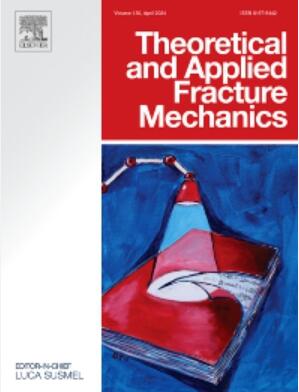Investigation on the dynamic fracture behavior of three-centered circle twin tunnels containing a joint under impact loading
IF 5
2区 工程技术
Q1 ENGINEERING, MECHANICAL
引用次数: 0
Abstract
This paper explored the dynamic failure mechanism of three-centered circle twin tunnels under dynamic loads and a joint is located in the surrounding rock mass, a combined method of model tests and numerical simulations is adopted in this paper. Dynamic fracture tests were conducted using a split-Hopkinson pressure bar (SHPB) apparatus by employing a model of a three-centered circle of twin tunnels. The dynamic fracture behavior of three-centered circle twin tunnels was analyzed by using a digital image correlation (DIC) method. Meanwhile, numerical simulations were carried out using the RHT constitutive model in LS-DYNA software to reveal the stress distribution law and the influence of the concrete initial support structure. The fracture extends in the direction of the stress wave propagation and converges at the tunnel shoulder region, some fractures extend along the stress wave direction at the joint tips and converge at the tunnel shoulders. Based on the dynamic mechanical behavior analysis, pre-joint significantly reduce the dynamic compressive strength (DCS) and elastic modulus of the twin tunnels. At low inclination angles (0°–30°), especially at 0°, the DCS and dynamic elastic modulus experience a reduction of 16.89 % and 13.08 GPa, respectively. With the rise of the inclination angle, the DCS and dynamic elastic modulus exhibit a progressive recovery trend, and are close to the level of the specimen without prefabricated cracks at high inclination angles (75°–90°). The dynamic stress concentration factor (DSCF) analysis shows that the increase of support significantly reduces the stress concentration degree at various locations around the tunnel, especially in vulnerable areas, which further improves the stability of the tunnel. When the joint dip angle is from 60° to 90°, crack propagation paths show multi-branch characteristics, and the interaction between tunnels is limited. The DSCF in the tunnel crown and bottom areas is the key factor initiating failure. The concrete initial support significantly enhances the twin tunnels’ resistance to dynamic disturbance load, reducing the normalized damage volume by up to 37.37%.
冲击荷载作用下含节理三心圆双隧道动态断裂行为研究
本文采用模型试验与数值模拟相结合的方法,探讨了动荷载作用下围岩设节理的三心圆双隧道的动力破坏机理。采用三心圆双隧道模型,采用分离式霍普金森压杆(SHPB)装置进行了动态断裂试验。采用数字图像相关(DIC)方法分析了三心圆双隧道的动态断裂行为。同时,利用LS-DYNA软件中的RHT本构模型进行数值模拟,揭示混凝土初始支护结构的应力分布规律和影响。裂缝沿应力波传播方向延伸,在隧道肩区收敛,部分裂缝沿节理尖端应力波方向延伸,在隧道肩区收敛。基于动态力学行为分析,预缝显著降低了双隧道的动态抗压强度和弹性模量。在低倾角(0°-30°)下,特别是在0°时,DCS和动态弹性模量分别降低了16.89%和13.08 GPa。随着倾角的增大,DCS和动弹性模量呈逐步恢复趋势,且在大倾角(75°~ 90°)时接近无预制裂纹试件水平。动应力集中系数(DSCF)分析表明,支护的增加显著降低了隧道周围各部位的应力集中程度,尤其是脆弱区域,进一步提高了隧道的稳定性。节理倾角在60°~ 90°范围内,裂缝扩展路径呈现多分支特征,隧道间相互作用有限;隧道顶部和底部的失稳应力是引发隧道破坏的关键因素。混凝土初始支护显著提高了双隧洞抗动扰动荷载的能力,使归一化损伤体积减小了37.37%。
本文章由计算机程序翻译,如有差异,请以英文原文为准。
求助全文
约1分钟内获得全文
求助全文
来源期刊

Theoretical and Applied Fracture Mechanics
工程技术-工程:机械
CiteScore
8.40
自引率
18.90%
发文量
435
审稿时长
37 days
期刊介绍:
Theoretical and Applied Fracture Mechanics'' aims & scopes have been re-designed to cover both the theoretical, applied, and numerical aspects associated with those cracking related phenomena taking place, at a micro-, meso-, and macroscopic level, in materials/components/structures of any kind.
The journal aims to cover the cracking/mechanical behaviour of materials/components/structures in those situations involving both time-independent and time-dependent system of external forces/moments (such as, for instance, quasi-static, impulsive, impact, blasting, creep, contact, and fatigue loading). Since, under the above circumstances, the mechanical behaviour of cracked materials/components/structures is also affected by the environmental conditions, the journal would consider also those theoretical/experimental research works investigating the effect of external variables such as, for instance, the effect of corrosive environments as well as of high/low-temperature.
 求助内容:
求助内容: 应助结果提醒方式:
应助结果提醒方式:


